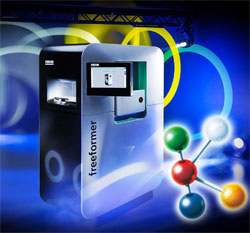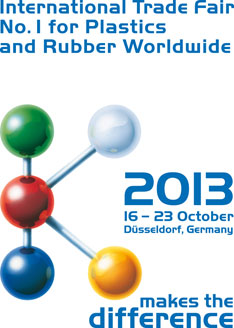
| K-Fair Special Coverage |
Arburg enters additive manufacturing business and introduces equipment during K’2013
Arburg´s freeformer produces fully functional plastic parts using the new additive manufacturing technique – ARBURG Plastic Freeforming (AKF) – from 3D CAD files, from standard granulates and without a mould. It therefore offers freedom for the efficient production of individual parts and small-volume batches. On the basis of around 60 years of expertise in plastics processing and machine construction, Arburg has developed the freeformer and AKF in-house – for comprehensive production efficiency. This innovative solution offers greater freedom in the choice, combination and processing of plastics, component production without support structures and a dust-free production environment. Unlike conventional additive manufacturing techniques, with ARBURG Plastic Freeforming (AKF) standard granulates are melted as in the injection moulding process. The freeformer produces the component without support structures, layer by layer from minuscule droplets. The discharge unit with nozzle remains stationary, while the component carrier moves. The AKF process makes use of 3D CAD files, which are read in directly by the freeformer. After start-up, everything else takes place automatically. A nozzle closure with piezo technology builds up the desired component layer by layer from minuscule plastic droplets. During this process, the item under construction is moved by a component carrier with three or five axes.
Arburg's stand at K 2013 (In Hall 13, Stand A13) also displays much more, demonstrating how plastic parts can be produced efficiently. Other top-class world premieres from the machine, process and applications segments are presented in Düsseldorf, as follows: Premiere: electric ALLROUNDER 820 A - Among the injection moulding machines, the electric Allrounder 820 A, which completes the high-end electric Alldrive machine series, will celebrate its world premiere in Düsseldorf. Both the 4,000 kN toggle-type clamping unit and the size 2100 electric injection unit have been newly developed for this machine. The gap between 3,200 and 5,000 kN in the electric clamping unit range has thus been closed. The same applies to the high-performance hybrid Hidrive range, for which this new toggle size will also be available in future. With the new clamping force and injection unit sizes for electric machines, the modularity of the Arburg range has been further enhanced, offering customers the option of adapting their Allrounders even more precisely to the relevant application and product, further increasing efficiency. Premiere: six-axis robotic system suspended on linear axis - For the automation segment, Arburg will jointly present a world innovation with its cooperation partner fpt Robotik in the form of an Agilus six axis robotic system from Kuka with integrated Selogica user interface. The system is suspended from a linear axis arranged transversely to the machine. The combination of a six-axis robotic system with a linear axis permits more dynamic movements and faster entry into the mould. This results in shorter cycle times and higher productivity. A further benefit of this mobile solution is the greater working area available as the small robotic system can move on the axis and the floorspace below can be used without restriction. The Agilus robotic system can thus perform a wide variety of moulded part production tasks. In terms of size and performance, it is designed for load weights between 6 and 10 kg – ideal for plastics processing requirements, making it a cost-effective handling solution. Application highlight: Particle-foam Composite Injection Moulding - The new automation solution will be presented on a two-component Allrounder 470 S, on which the further development of Particle-foam Composite Injection Moulding (PCIM) will be presented. This relatively new process, which was developed jointly by Ruch Novaplast, Krallmann and Arburg, opens up completely new possibilities in lightweight construction. On the exhibition machine at the K, a plastic wheel rim is injected onto an inserted particle-foam tyre. Transfer of the pre-moulded part to the mould is followed by overmoulding of the tyre with TPE. The six-axis robotic system performs all the necessary handling tasks, from insertion of the foamed tyre through to transfer of the finished parts to the packaging system, which features printing of the bags during the running process. Application highlights: long-fibre direct injection moulding combined with organic sheet - As a further innovative process for lightweight construction, Arburg will present long-fibre direct injection moulding. Here, for the first time, glass fibres with a length of up to 50 mm can be added directly to the liquid melt, where they are homogeneously distributed. The fibre length, fibre content and material combination can also be individually adjusted. The new process offers high flexibility and the possibility of developing in-house know-how. Moreover, considerable cost savings can be achieved because the base materials, plastic and fibreglass rovings, are cheaper than finished long glass fibre granulates. The process will be demonstrated on an energy-optimised hydraulic Allrounder 820 S with servo-hydraulic drive, operating with a mould from Georg Kaufmann Formenbau AG. Through the overmoulding of continuous-fibre reinforced thermoplastic inserts (organic sheets), high-strength, resilient composite parts are created, which weigh less than 300 grams at a length exceeding 500 mm. Organic sheets combine two or more materials in a targeted manner, whereby their properties mutually enhance one another. The continuous fibres – generally glass, carbon and aramide in woven and non-woven forms – determine the mechanical properties such as strength and rigidity. The matrix material is responsible for the force transfer between the fibres in the composite and protect the reinforcing structure from buckling and environmental influences. In this application, a six-axis robot picks up the organic sheets from a magazine. These are gently heated and transferred to the LIPA (Lightweight Integrated Process Application) mould at the forming temperature. Here, forming of the insert and injection moulding of the functional and reinforcement elements such as edging, end eyes and ribbed structures take place simultaneously in a cycle time of around 40 seconds. The produced component provides a good illustration of how lightweight parts can be produced with a high level of functional integration and short cycle times by combining organic sheets and long-fibre direct injection moulding. Source: Arburg
|
 October 16, 2013 -
Arburg has expanded its product portfolio to include additive manufacturing, opening the door to new possibilities in plastic parts production. At the K 2013, the german injection molding machines manufacturer has revealed its secret and presented the unique freeformer and ARBURG Plastic Freeforming (AKF) to the plastics trade.
October 16, 2013 -
Arburg has expanded its product portfolio to include additive manufacturing, opening the door to new possibilities in plastic parts production. At the K 2013, the german injection molding machines manufacturer has revealed its secret and presented the unique freeformer and ARBURG Plastic Freeforming (AKF) to the plastics trade. 
